In September of 2000 the Redwood Empire Handweavers and Spinners Guild (now Redwood Guild of Fiber Arts) offered a workshop by an Australian weaver, Liz Williamson, called “The Textured Surface”. Liz transformed very simple, nearly gauze like, plain weave cloth through her choice of weave structure, yarns, washing and finishing. I was intrigued. Up to this point in time my own focus had been on weaving painstakingly perfect fabrics using color and texture and embellished with repetitive motifs done in inlay and brocade. They were lovely, satisfying, and extremely slow weaving.
Needless to say, the spontaneity I experienced in Liz’s class was refreshing, and piqued my curiosity. Since 2000 I have been exploring these ‘textured surfaces’ and producing a line of scarves, shawls, ponchos, and now cowls, using collapsed weave techniques, and most specifically in my work, using “differential shrinkage.”
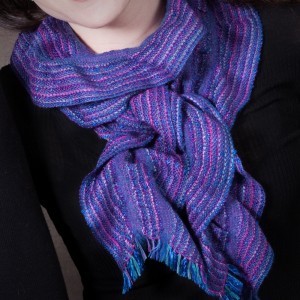
Ruffled Scarf
According to Anne Field, collapsed weave refers to fabrics that “have one feature in common: collapse cloth is flexible and fluid in movement.” It refers to cloth that changes appearance either after releasing the tension of the loom, or after washing the cloth. The normal rigid intersection of warp and weft is distorted either by structure or finishing, and moves into pleats, puckers, ruffles, waves, scallops, and other fluid movements.
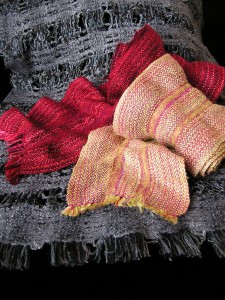
Rustic lace shawl with ruffled scarves
This was the clincher for me…I love the transformation of the cloth and the slightly unpredictable nature of the whole experience. To take a 96” rectangular length of hand woven cloth, put it into a super hot washing machine, full agitation, full cycle and retrieve a wonderfully ruffled 55” cloth, air dry it and transform it even further with careful pressing is like magic to me.
My investigation of collapse weave has focused on the use of “differential shrinkage” or as Anne Fields calls it, “active and passive” yarns. Active yarns can be those that are over twisted or yarns that shrink. I use shrinking yarn in opposition to yarns that don’t shrink at all or have very little shrinkage in relation to “the shrinker.” My shrinker of choice is Jaggerspun super fine merino but I have also had some success with various alpacas or alpaca merino blends. For my passive yarns I use an abundance of choices… tencels, rayons, cottons, silks, poly’s or blends of any of these. I am a great fan of the sale bin at knitting stores where I can find one or two balls of an awesome passive yarn to throw into the mix.
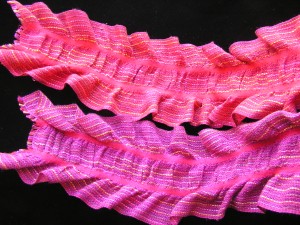
And more ruffled scarves
To weave a project using differential shrinkage, you proceed as you would with any other project. First you need decide on a design. In order to create ruffles, scallops, etc. you have to make a warp plan that places your active “shrinking” yarns in opposition to your passive yarns. You will be basically designing a striped warp with the shrinkers placed strategically to create the effect you want. I have included some various design ideas I share
with my students to help you get started.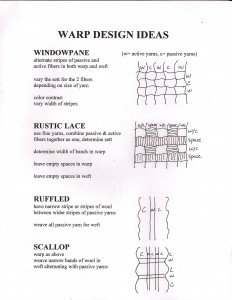
For example, equal width stripes of passive and active yarns will give you puckers (windowpane) or one narrow band of your merino down the center will give you a ruffle (ruffled).
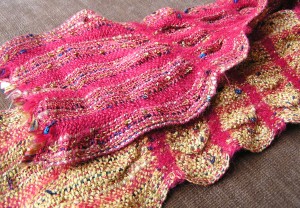
Scallopped scarves
Once you have chosen your active and passive yarns you are now able to figure your sett which should be slightly looser than for a normal plain weave in order to allow the shrinkage to occur ( for example- from 15epi to 12epi). Your sett for the merino or alpaca area may be different than for your non shrinking areas depending on the diameter of the yarns you use.
In doing your calculations, predetermining your shrinkage is a tough one. It’s always a good idea to weave a sampler before weaving your project, however, if you are like me, you will find that most undesirable. You could try to determine the shrinkage by taking a measured length of the fibers, washing them how you intend to wash this project (hot water!), letting it dry and then measuring it again to figure your shrinkage. This actually does work although I have found that there are so many variables in the finishing process that it is definitely not an exact science. I can weave 2 scarves with the same materials and have them come out different lengths depending on whether my teenage daughters have just showered or not!
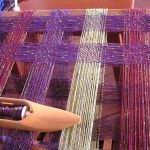
Rustic lace on the loom
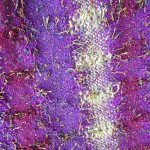
Rustic lace fabric after finishing
Next, wind your warp, dress your loom as usual and you are ready to weave. Whether you weave with just passive yarns or with a mix will depend on your design. Wherever you weave with your merino or shrinker in the weft will be a shrinking area and draw in considerably in the finishing. Think how you want to see the cloth transformed …ruffles, scallops? Again, as with your sett, you want to weave slightly more open than a normal tabby to allow room for the shrinkage to occur.
So far there is nothing unusual about the look or shape of the fabric except that you might be nervous that you wove it too loosely. Now comes the magic moment… washing and finishing! Don’t forget to secure your edges either by tying knots, hemstitching or machine stitching. When finishing my scarves, I use a top loader washing machine, hot water wash, cold rinse, set for a full cycle and a mild detergent such as Ivory liquid dish detergent. If the idea of throwing this delicate fabric into the washing machine with such extreme temperatures and time starts you hyper ventilating then start with a gentler wash and shorter times. You can always make it felt more by repeating the cycle but it is pretty impossible to stretch out an overshrunk scarf! I love opening the machine to see what has happened to the cloth… it never ceases to amaze me how much it changes. However, even further transformation comes when, after you have air dried your piece, you take it to the ironing board and work the magic of steam to smooth out the ruffles, waves, or scallops and to bring a final sheen to the fabric. A little trim of the fringe and you have an amazing piece of cloth that has gone from flat to 3 dimensional with a sculptural aspect to it that reflects the light and creates shadow and is truly “fluid in movement”.